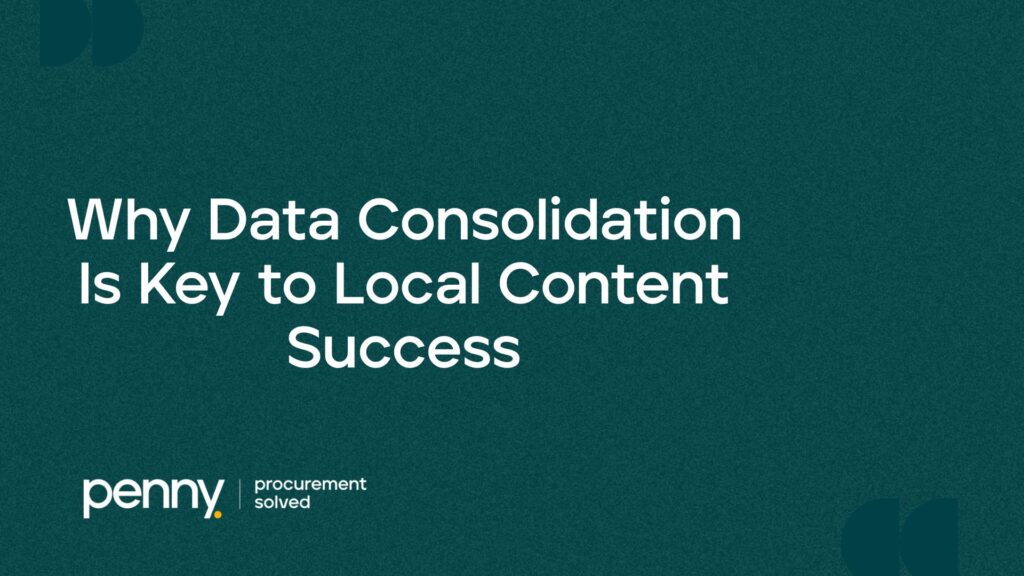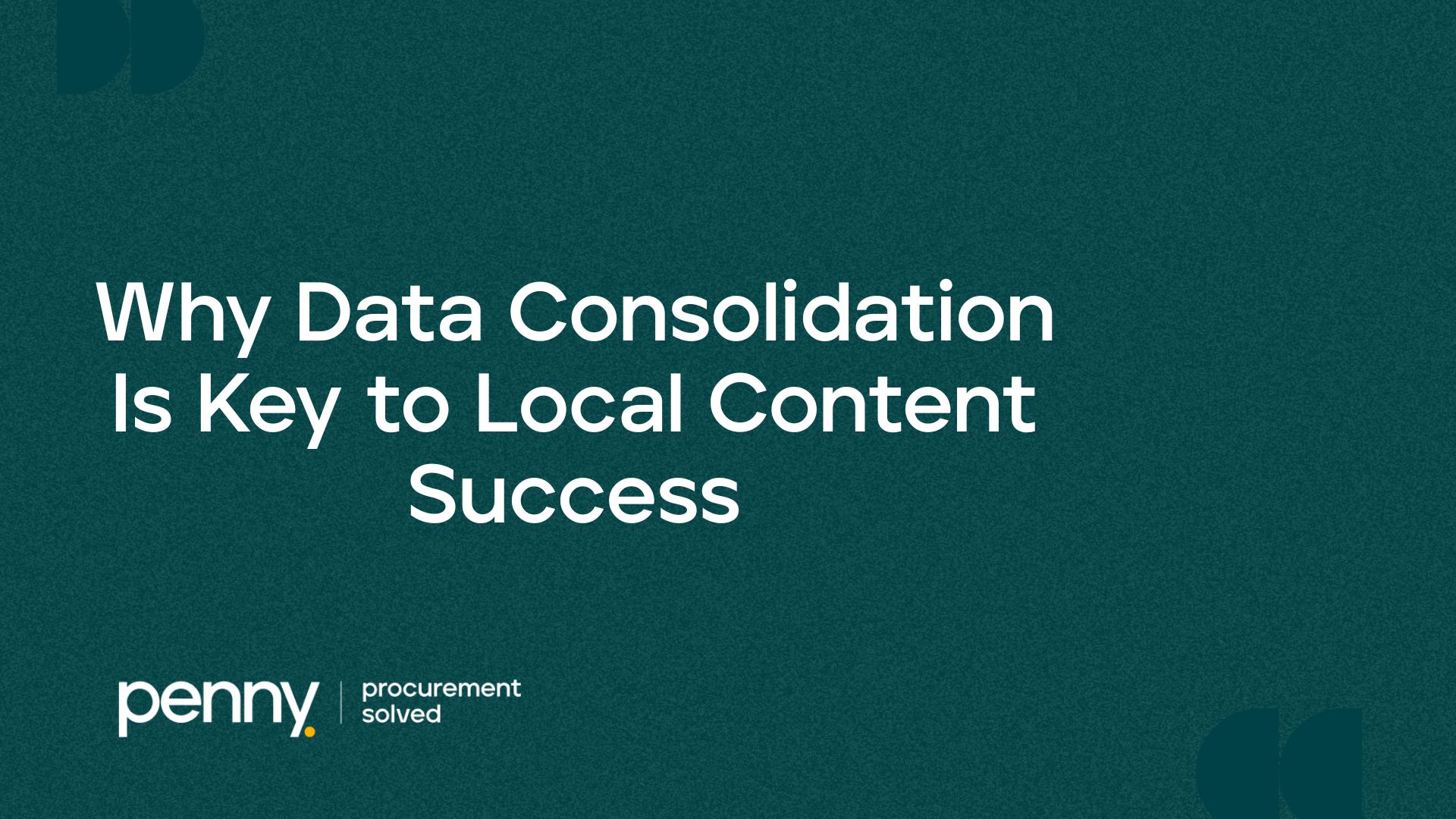
In our previous blog, we discussed how Penny’s Local Content Tracker streamlines the traditionally manual and fragmented process of calculating Local Content (LC) scores. Now, we turn our attention to one of the biggest challenges organizations face in their compliance journey: data silos. These silos obstruct visibility, hinder accuracy, and make Local Content tracking a reactive exercise rather than a strategic one. The key to overcoming this? Consolidating your data across departments, systems, and formats into one unified platform.
The Reality of Disconnected Systems
Let’s start by acknowledging the current landscape. In most organizations, procurement, HR, finance, and training teams each operate their own systems and data repositories. Procurement uses an ERP or procurement system, HR might be working from a payroll solution, training initiatives are often tracked through spreadsheets and finance uses accounting software. All of this information is critical to calculating your baseline Local Content score, but when it’s scattered across multiple systems, coordination becomes slow, difficult, and error-prone.
This lack of integration doesn’t just delay audits. It distorts the accuracy of your LC score and weakens your ability to act strategically and prevents you from fully leveraging your Local Content performance as a competitive advantage.
What Data Consolidation Looks Like in Practice
Penny’s Local Content Tracker solves this by consolidating your data across all four LCGPA Local Content pillars into a single, automated system. Here’s how:
Pillar 1: Goods & Services
This involves transactional data related to spend on procurement data, Goods Receipt Notes, vendor payments, credit notes, consumed inventory, and journal entries. Typically scattered across multiple ERP modules or even spreadsheets, this data is imported into the Tracker, categorized using predefined logic aligned with LCGPA scoring methodology.
The Tracker classifies suppliers (local/foreign), identifies categories and applies the appropriate contribution percentage automatically.
Pillar 2: Labor
Labor costs are often tracked in payroll systems or managed by HR teams in spreadsheets. The Tracker captures this data, both local and foreign salary breakdowns, and calculates the weighted contribution to your labor LC score. No manual data sorting required.
Pillar 3: Capacity Building
Data on training programs and supplier development is often scattered across ad hoc documents. Penny’s Tracker organizes this information into structured reporting fields using standard templates, either through bulk upload or seamless API integration.
Pillar 4: Depreciation & Amortization
Finance teams manage this data in fixed asset registers or accounting software. The Tracker distinguishes between local and foreign assets and accounts their respective depreciation or amortization, ensuring it aligns with LCGPA rules.
From Fragmented to Unified: The Technical Backbone
How does Penny make this work? At the heart of the platform is a flexible data ingestion layer designed to adapt to your existing setup. Whether you’re using ERP systems or just Excel sheets, the Tracker can:
- Connect directly to ERP systems via secure APIs
- Accept structured CSV/Excel uploads for historical or ad hoc data
- Interface with middleware for more complex integrations
Each uploaded dataset undergoes automated validation and classification to ensure the data is ready for score calculation and reporting. No more manual transformations or last-minute data cleanup.
The Power of One Source of Truth
Consolidating your data doesn’t just make Local Content tracking easier. It fundamentally changes how your organization operates.
1. Transparency and Traceability
With one unified system, every department sees the same data, calculated using the same logic. Procurement knows how their suppliers are classified. HR sees their labor impact. Finance can trace how assets contribute to the score. And the compliance team can generate audit-friendly reports in minutes.
2. Better Cross-Department Collaboration
When all departments input their data into a shared system, alignment becomes effortless. At audit time, instead of chasing multiple departments for scattered data, risking delays or missing information, everything is already consolidated, structured, and ready to use.
3. Faster Strategic Decisions
A real-time, centralized platform empowers leadership to act quickly. Want to know how replacing a vendor would impact your score? Or whether you should increase your training budget? With consolidated data, these questions can be answered instantly, not after weeks of back-and-forth.
Going Beyond Data Collection: Intelligence Layer
What sets Penny apart isn’t just data consolidation, it’s the Intelligence Layer that transforms that data into actionable insights, enabling faster, smarter decisions.
Smart Mapping Rules
Once data is uploaded or synced, it’s processed through automated classification logic based on LCGPA’s framework. The system:
- Tags each line item with the relevant pillar
- Applies the correct contribution percentage
- Calculates weighted impact
- Flags inconsistencies or missing entries
Live Dashboards
The consolidated data feeds into dashboards that update in real time. You can track LC performance across each pillar, benchmark against targets, and drill down into project/department-level contributions.
The Impact: More Than Just Compliance
Data consolidation doesn’t just improve LC score tracking. It drives real business outcomes:
- Real-Time Transparency: Turn raw data into shared visibility across teams, enabling better alignment with localization goals.
- Competitive Advantage: Use strong LC performance to win more tenders.
- Cost Efficiency: Reduce consultant reliance and eliminate manual reporting overhead.
- Risk Mitigation: Identify compliance gaps early to avoid penalties and strengthen your LC position.
Conclusion
As Local Content evolves from a compliance checkbox to a strategic driver, data consolidation becomes the backbone of effective execution. Without it, even the strongest strategies risk falling short.
Penny’s Local Content Tracker addresses this challenge by unifying your data and converting it into meaningful insights, enabling continuous performance optimization and smarter decision-making.


